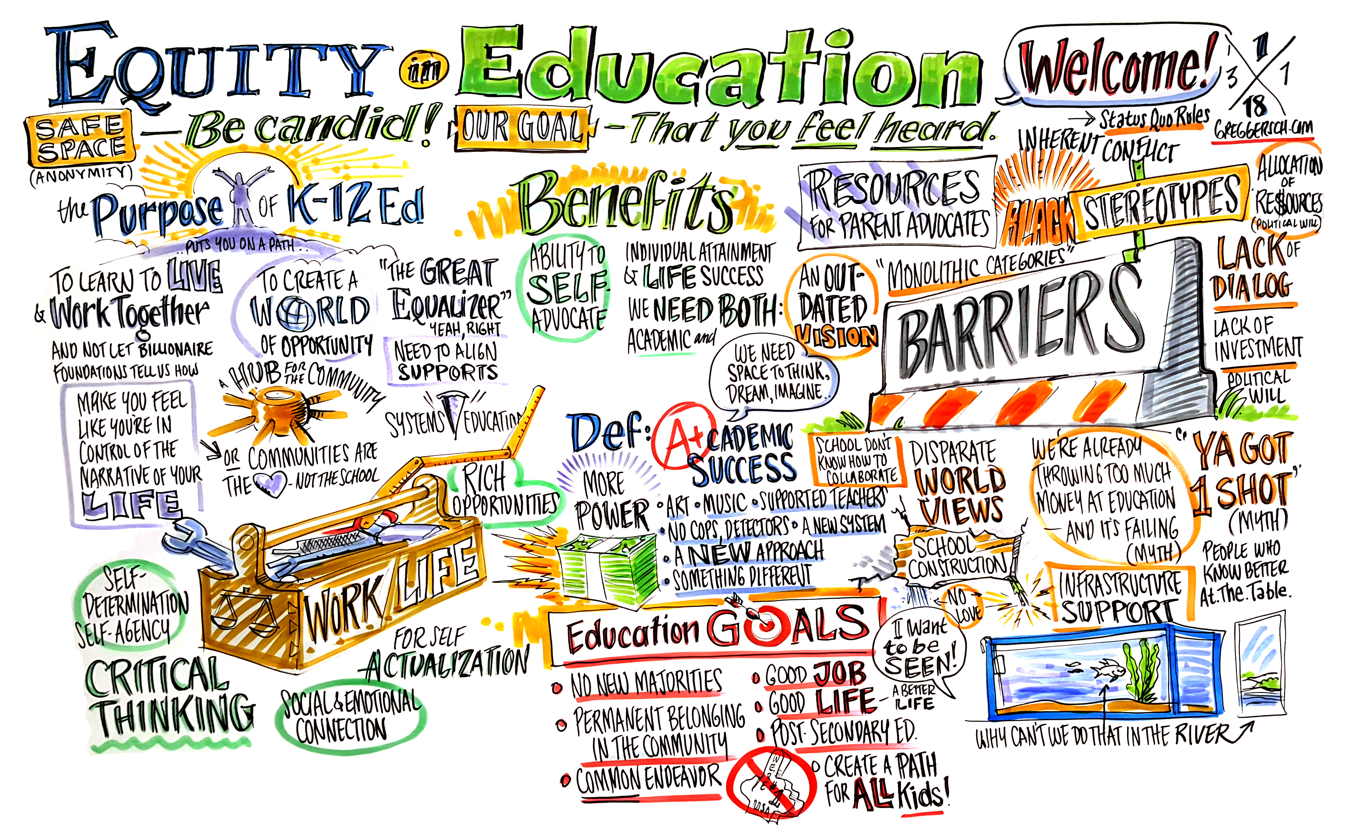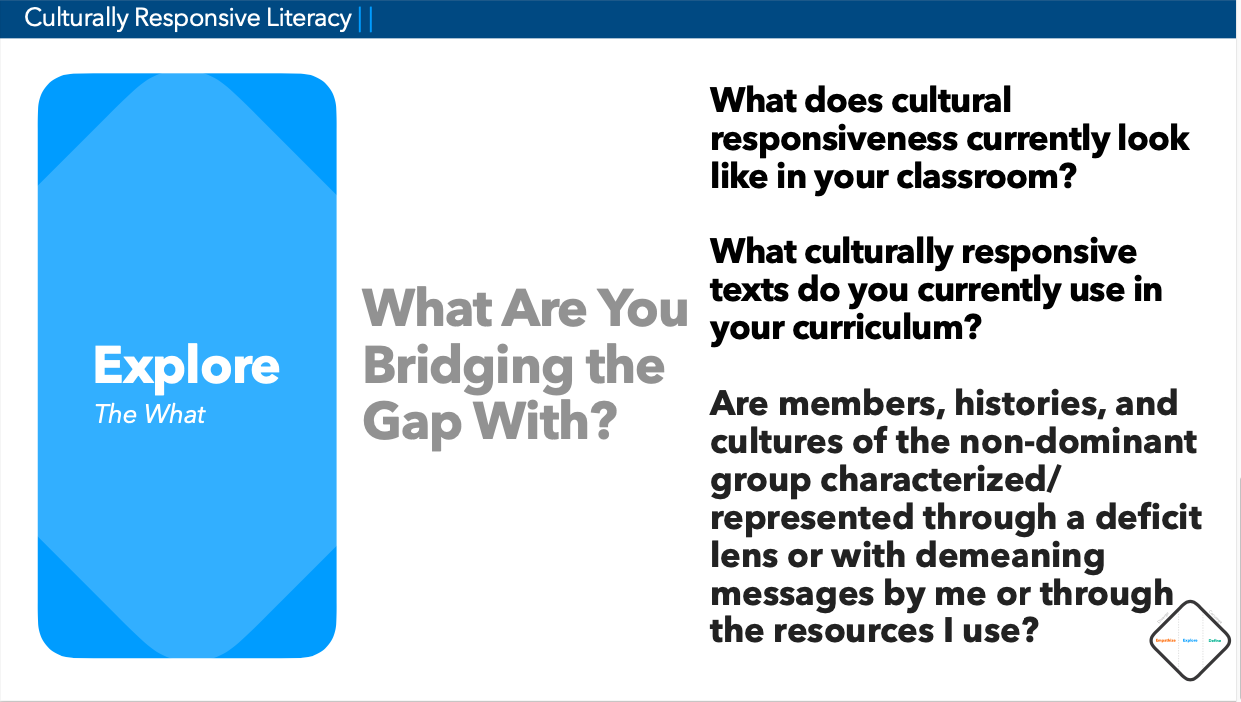An Equitable Education
If we find ourselves nodding at this picture that has circulated through our industry for many years, then what are we doing in our current roles to ensure this is not the case for our kids?
The Organization for Economic Co-Operation and Development (OECD) (2018) gave the following statement regarding high performing schools:
“Clearly, the most impressive outcome of world-class school systems is that they deliver high-quality education across the entire school system so that every student benefits from excellent teaching. Achieving greater equity in education is not only a social-justice imperative, it is also a way to use resources more efficiently, and to increase the supply of knowledge and skills that fuel economic growth and promote social cohesion. Not least, how we treat the most vulnerable students shows who we are as a society” (4).
Buzz words are well known in the education world, sometimes made to become a commonplace cliche. However, when we truly understand the implications behind what it means to provide an equitable education and the long term impact it can have on the lives of others, it cannot be put on a shelf. It becomes a part of who you are, clarifies the way you see and interact with any situation, and confirms your conscience. Make no mistake, this is a system-wide effort in working toward providing an equitable education for our kids.
With that, a few questions come to mind:
How might we, as an entire system, identify ways in which we are contributing to the equity gap?
How might leaders ensure they have understood, embraced, and implemented a culture that nurtures equity?
How might leaders guarantee teachers have what they need to succeed in this effort?
How might teachers identify what they are missing and need additional support in to achieve an efficient, sustainable infusion of equitable classrooms?
The African proverb, “It takes a village to raise a child”, is more true now than ever before.
“A school system that is truly equitable therefore is essentially one where all students reach their full potential, irrespective of their starting point or background”
Equity
From “Culturally Responsive Literacy” (Chollett, 2020)
Giving learners opportunities to succeed no matter where they are at, while maintaining high expectations and a belief in them, belongs in every facet of our world. It is not Kool-Aid. It is a deeply rooted acknowledgement, empathy, and celebration for humanness. How then, as educators, are we able to ensure that equity is not simply a goal, but rather interwoven throughout every practice, behind every decision, and within our entire culture’s DNA? (Not only for our learners, but for ourselves as well).
A simple answer begins with understanding what an equitable education looks like, feels like, and sounds like at all levels of a school system. Looking not only for diverse representation throughout the system, but analyzing how decisions are made to uphold fully inclusive implementations and results. “Walking the walk”, if you will.
The systemic nature of education necessitates that all players within it have a vital role when contributing to a successful equitable education experience for our kids. From the superintendent to administration to directors to teachers to paras to office staff to custodial staff to lunch staff to bus drivers and beyond, everyone plays a vital role.
Education Equity
“The Organization for Economic Co-Operation and Development (OECD) defines two dimensions of equity in education:
Fairness, which means ensuring that personal and social circumstances do not prevent students from achieving their academic potential.
Inclusion, which means setting a basic minimum standard for education that is shared by all students regardless of background, personal characteristics, or location” (Thinking Maps, OECD)
Words Matter
What we believe and are made to believe of ourselves can very well dictate what we do, how we perceive, and how we make decisions; a self-fulfilling prophecy.
How we talk to each other has deep implications on our conscious and subconscious mind. It is the difference between saying, “+2” versus “-18” on an assessment. Or discussing the growth you see in a learner versus only discussing the proficiency level a learner is performing at on a standardized test. Dr. Maxwell Maltz, author of “Psycho-Cybernetics” (Maltz, 1960; Furey, 2015), said, “A human being always acts and feels and performs in accordance with what he imagines to be true about himself and his environment” (p. 28). What we believe and are made to believe of ourselves can very well dictate what we do, how we perceive, and how we make decisions; a self-fulfilling prophecy. In order to cultivate and nurture a growth mindset (Dweck, 2007), words we use with learners contribute to the process. As they take in words and ideas about themselves that are asset-based rather than deficit-based, there is a better chance of developing a positive self-image that feeds a growth mindset.
Dr. Pedro Noguera, Distinguished Professor of Education at the Graduate School of Education and Information Studies at UCLA and founder of UCLA’s Center for the Transformation of Schools (Gonzalez, 2018) further emphasizes the need for us as adults in the education system to speak up on behalf of equitability, because those words matter, too. “This is easier said than done...because it can mean having uncomfortable conversations, but it’s absolutely necessary for progress to occur (Gonzalez, 2018). Conversations turn into solutions. Solutions turn into action. However, we don’t know what we don’t know, further proving the need for us to speak up.
Quality Questions Produce Quality Outcomes
From “Culturally Responsive Literacy” (Chollett, 2020)
Everyone comes with different sized and shaped backpacks in life. Some of us have heavier backpacks than others. Some are missing a strap on their backpack. Some backpacks are so worn down that they barely hold anything anymore, no matter how hard we try to hold it all together. Regardless of the backpack any one person is carrying, it exists and within the backpack can uncover the reasons for everything if we stop for a moment and consider the right questions.
All humans are unique and navigate the world in their own way. To identify ways to support each other’s uniqueness, the questions we ask uncover what we are/want to be optimizing for.
Where it begins with us educators is exploring how and why we do what we do; lesson plan, grade, evaluate and discuss skills, choose curricula, give and receive feedback, and implement various strategies and elements into our classes. Just because we are a part of a system does not mean the system is what has to create us. The systems in which we find ourselves making our ways through can be rigid, yes. However, the system is also comprised of unique human beings who are all different in their own way. For us to acknowledge and appreciate this changes the way in which we do what we do.
Cultural Considerations
Rings of Culture
Dr. Sharroky Hollie’s “Rings of Culture” (The Center for Culturally Responsive Teaching and Learning) helps us acknowledge and interact with the various cultures we and others come from. He enlightens us to acknowledge that there are multiple layers to any one human being, those layers are valid, and can tell a story unlike one our assumptions may create.
Hollie’s Rings of Culture (2015) from “Culturally Responsive Literacy” (Chollett, 2020)
Levels of Culture
Zaretta Hammond’s “Culture Tree” (2015) (Culturally Responsive Teaching and the Brain) allows for us to consider the depths of culture variants. These acknowledgments help us ask questions that become more unique to our learners and to ourselves.
Hammond’s Levels of Culture (2015) from “Culturally Responsive Literacy” (Chollett, 2020)
From Questions to Craft
Muñiz’ culturally responsive competencies (2019) from “Culturally Responsive Literacy” (Chollett, 2020)
Asking the right questions allows us to explore and consider the equitable possibilities for our learners that create equitable opportunities throughout our school system and beyond. As we work through and develop lessons, activities, assessments, and more, utilizing frameworks can support us in maintaining our main objectives with an equity lens. Jay McTighe and Grant Wiggins’ Understanding by Design (Ubd)(2005) ASCD framework supports the backwards design development approach that sustains a meaningful process and structure for educators. To further ensure we are applying equitable considerations that keep us from biased assumptions, Jenny Muñiz’ Culturally Responsive Teaching New America report (2019) identified eight teacher competencies that promote culturally responsive teaching.
Throughout multiple iterations, I have developed (and continue to refine) the UbD Unit Template, developed from Wiggins and McTighe’s work (2005; ASCD) and infused with Muñiz’ eight teacher competencies (2019; New America). This framework has allowed me to remain grounded in the purpose of why I do what I do.
This is complex work, but the more we discuss equity, the better we become at understanding, identifying, generating, and implementing equitable opportunities.
References
Alma Harris & Michelle Jones (2019) Leading for equity, School Leadership & Management, 39:5,391-393, DOI: 10.1080/13632434.2019.1669788
Center For Public Education. (2016). Educational Equity What does it mean? how do we know when we reach it? Educational Equity What Does It Mean? How Do We Know When We Reach It?, January, 1–10. https://www.nsba.org/-/media/NSBA/File/cpe-educational-equity-research-brief-january-2016.pdf
Gonzalez, J. (2018, December 3). 10 Ways Educators Can Take Action in Pursuit of Equity. Cult of Pedagogy. https://www.cultofpedagogy.com/10-equity/
Hammond, Z. (2015). Culturally responsive teaching and the brain: Promoting authentic engagement and rigor among culturally and linguistically diverse students. Thousand Oaks, CA: Corwin.
Hollie, S., Davis, A., & Andrew, E. (2015). Strategies for Culturally and Linguistically Responsive Teaching and Learning. Huntington Beach, CA: Shell Education.
Jones-Goods, K. M. (2019). Culturally Responsive Literacy Instruction. Journal of Research Initiatives, 4(2), 9.
Lawrence-Brown, D., & Sapon-Shevin, M. (2015). Condition critical—Key principles for equitable and inclusive education. Teachers College Press.
Learning Policy Institute. (2020). The Federal Role in Advancing Education Equity and Excellence. Palo Alto, CA: Author.
Muñiz, J. (2019). Culturally Responsive Teaching: A 50-State Survey of Teaching Standards. New America.
Waterford. (2019, May 2). Why Understanding Equity vs Equality in Schools Can Help You Create an Inclusive Classroom. Waterford.Org. https://www.waterford.org/education/equity-vs-equality-in-education/
Wiggins, G., Wiggins, G. P., & McTighe, J. (2005). Understanding by design. Ascd.








